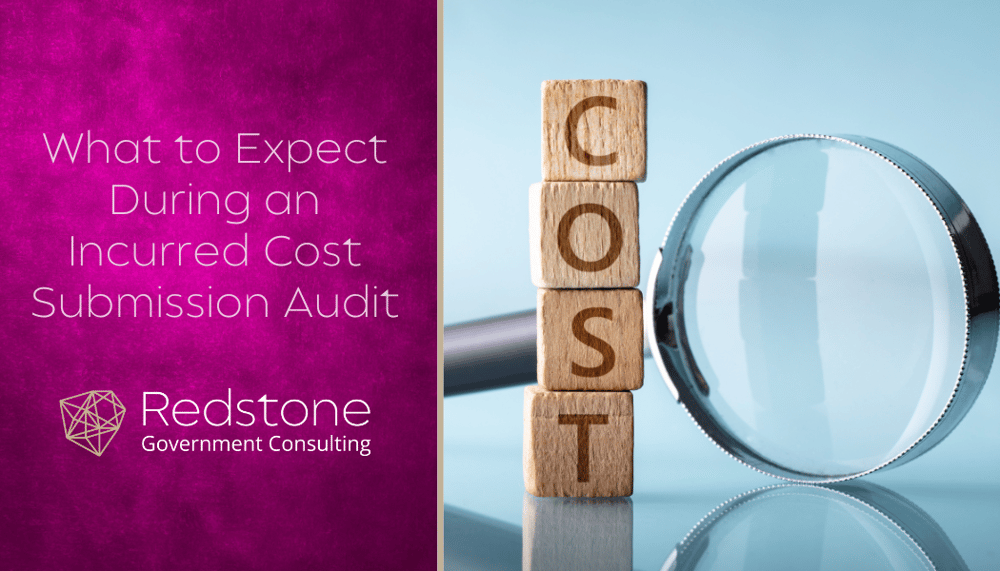
Contractors with cost reimbursable contracts that include the Allowable cost and payment clause, FAR 52.216-7 or Payments under Time-and-Materials and Labor-Hour contracts clause, FAR 52.232-7, are required to submit an Incurred Cost Proposal for each fiscal year costs were incurred on any cost reimbursable contract. This incurred cost proposal is provided to your Administrative Contracting Officer (ACO) and Defense Contract Audit Agency (DCAA) with a deadline of six months after the Contractor’s fiscal year end. Once the Incurred Cost Proposal is received by DCAA, they review it for adequacy. DCAA provides a notification to the Contractor, typically via email, that the proposal is deemed adequate for audit or outlines changes DCAA believes are necessary. That is great to know it is adequate for audit but what does that mean? This means that DCAA has reviewed the incurred cost proposal and determined that the schedules are properly completed for them to begin the audit potentially.
The Selection Process for Incurred Cost Audits
Once your incurred cost submission is deemed adequate for audit, it is included in a pool with other contractors and then a selection is made on which contractors are audited. If you are selected from this pool, then your incurred cost proposal is audited. All other contractors will receive a low risk memo for that fiscal year. A low-risk memo will also come with an auditor determined rates letter (using your proposed rates) for you to sign that will set final indirect rates for the fiscal year. While DCAA does not publish the sampling plan, it appears to us that the number of proposals sampled is broken out by auditable dollar value and very low in total. It also appears most sampled audits are given to CPAs to perform.
In recent years, Congress has required Incurred Cost Audits be performed by Independent Public Accounts (i.e., a CPA firm) for Incurred Cost Proposals with DoD contracts. Contracting Officers for Civilian Agencies (e.g., NASA), perform their own assessments and either request audit services from DCAA or a CPA firm to perform the Incurred Cost Audit.
Incurred Cost Audit Notification
Now that you have been notified by DCAA or a CPA firm of the Incurred Cost Audit, what should you expect? The purpose of the Incurred Cost Audit is to express an opinion on whether the incurred costs are reasonable, allocable, and not prohibited by the contract, by government statute or regulation, or by previous agreement with or decision of the government contracting officer (i.e., unallowable). The incurred cost audit establishes final, government-approved direct and indirect costs for the fiscal year under review to assist in the final closeout of cost-reimbursable contracts.
Preparing for the Incurred Cost Audit
The initial step of the Incurred Cost Audit is the entrance conference where the introductions are made, expectations are set, and a long, long list of requested information is provided. A Contractor has a right to know the purpose of the audit, the expected duration of the audit, and what the auditor will need to accomplish the audit. Take advantage of this time during the entrance conference to ask questions and establish the expectations. Some of the information that will be requested by an Incurred Cost Auditor will be a copy of:
- Financial statements,
- Federal and State Income Tax Returns,
- Disclosure Statement (if applicable),
- General ledger detail,
- Job cost detail,
- Quarterly 941s,
- Organization chart
During audit, all of the supplemental schedules will be requested such as:
- Supplemental Form A (1-4) – Comparison of FY schedules to prior year ICS schedules,
- Supplemental Form B – Executive Compensation,
- Supplemental Form C – Identification of Prime Contracts under which the contractor performs as a subcontractor,
- and Supplemental Form O – Contracts Briefs.
All of this information is reviewed and included in the audit file for various purposes. Key elements to have ready for an Incurred Cost Audit are an accounting system description and policies and procedures. Auditors review policies and procedures to develop an understanding of how the contractor’s accounting system operates. General Accepted Government Auditing Standards (GAGAS) requires the auditor to do this to properly plan the audit. Good internal controls, established in written policies and procedures and followed by management, are the backbone of any accounting system. Some auditors may choose to test internal controls as part of the incurred cost audit; however, this is not often the case, especially with DCAA auditors.
Audit Process and Resolution of Findings
The auditor’s primary objective is to determine that costs are allowable, reasonable, and appropriately allocated to Government contracts. Both direct and indirect costs are reviewed during the audit process. Unallowable costs should be segregated within the accounting system to ensure that these costs are not included in proposal to the Government. It is important to review the general ledger detail to ensure unallowable costs are excluded while preparing the Incurred Cost Proposal. Once the Incurred Cost Audit has started then no changes will be made until the audit is complete. Preparation for an audit starts during your daily accounting operations and well before any audit begins. The discipline of maintaining supporting documentation for costs incurred will mitigate the risk of audit issues due to what the auditor believes is inadequately supported costs. Costs that lack documentation are often questioned by an auditor. The burden of proof that costs are allowable is the Contractor’s responsibility.
Reviewing and Segregating Indirect Costs
When reviewing indirect costs for allowability the FAR Part 31 cost principles are the primary regulatory source. It is not unusual for the Contractor and Auditor to have conflicting interpretations of an “allowable costs” especially in those grey areas such as business meals, public relations, employee morale, and technical/professional activities. A Contractor’s best defense is supporting documentation to prove the costs are allowable per regulation. During review of indirect costs, an auditor will select certain accounts to review in detail to test for any unallowable costs. Auditors will typically focus on high risk areas such as business meals, travel, and miscellaneous accounts when testing to determine if unallowable costs have been included in the proposal.
Communication and Exit Conference
The auditor should discuss with the Contractor any audit issues that arise during the audit. The expectation is the Contractor will provide feedback on these findings on a timely basis. Cooperation between auditor and contractor will ensure the timely resolution of audit findings and allow a more effective audit process. However, the auditor does not make the final decision as to whether the cost is unallowable. The ACO has the warrant to make those decisions. For significant issue, the contractor should engage the ACO in the discussion early and not wait for the auditor to issue the report. Once the audit of direct and indirect costs has been completed, an auditor must hold a formal exit conference on each audit performed. The auditor is required to provide the results of the audit in writing and seek the Contractor’s reaction. Since the audit findings should have been discussed during the audit process, the exit conference should merely be a summary of issues and resolutions. The Contractor should be provided a draft of the audit report prior to the exit conference to have the opportunity to respond to the audit findings. Any Contractor comments will be included in the final audit report.
FAR 42.702 provides the conditions that determine whether the final indirect cost rates will be negotiated, or audit determined. If the contractor concurs with all the audit findings the indirect rates can be settled through the audit determined process, the Contractor will be asked to sign an audit-furnished indirect rate agreement on the indirect rates. If a Contractor does not agree with the auditor’s conclusion, the audit report will be sent to the Contracting Officer for resolution.
By signing the final indirect rate agreement letter, the Contractor is agreeing to the indirect rates as well as the cumulative costs and other information, for example, contract limitations, provided in the Cumulative Allowable Cost Worksheet (CACW) attached with the final indirect rate letter. This will be used to close out contracts. It is important to review these documents closely before signing to ensure the information is correct. Once this is signed, your indirect rates are final, and the audit is complete!
Redstone GCI is available to assist contractor’s in assessing their incurred cost as to allowable or unallowable as well as assist in the development of the proposal. Redstone GCI assists contractors throughout the U.S. and internationally with understanding the Government’s expectations in applying FAR Part 31, Cost Principles and completing incurred cost proposal requirements.


 Kimberly is a Managing Consultant with Redstone Government Consulting, Inc. based in our Huntsville, Alabama office. Her areas of expertise include working with government contract accounting and contracting issues and audit. Kimberly specializes in assisting government contractors in the unique accounting, pricing, proposal preparation, and compliance requirements of the U.S. Government. Professional Experience Kimberly’s experience includes preparation of complex incurred cost submissions, compliant accounting infrastructure, preparation and evaluation of policies and procedures, contract closeout process, developing provisional indirect rate budgets, monitoring actual indirect rates, and providing audit support to government contractors. Her primary focus is working pro-actively in preparing small contractors for government contract challenges as well as resolving DCAA issues. Kimberly has almost ten years of experience assisting clients with Federal Acquisition Regulations (FAR) and Cost Accounting Standards (CAS) best practices and compliance. She works with government contractors to comply with critical Federal Acquisition Regulations (FAR) requirements related to cost accounting and proposals. Her sundry experience with various government contract issues and successful resolutions provides insight that benefits our clients. Prior to joining Redstone Government Consulting, Inc., Kimberly specialized in assurance and advisory services with a regional firm (Jackson Thornton), working as a staff accountant conducting compilations and reviews, auditing financial statements and assisting with litigations. Education Kimberly earned a Bachelor of Science degree in Commerce and Business Administration from The University of Alabama in 2007. Affiliations National Contract Management Association Women in Defense
Kimberly is a Managing Consultant with Redstone Government Consulting, Inc. based in our Huntsville, Alabama office. Her areas of expertise include working with government contract accounting and contracting issues and audit. Kimberly specializes in assisting government contractors in the unique accounting, pricing, proposal preparation, and compliance requirements of the U.S. Government. Professional Experience Kimberly’s experience includes preparation of complex incurred cost submissions, compliant accounting infrastructure, preparation and evaluation of policies and procedures, contract closeout process, developing provisional indirect rate budgets, monitoring actual indirect rates, and providing audit support to government contractors. Her primary focus is working pro-actively in preparing small contractors for government contract challenges as well as resolving DCAA issues. Kimberly has almost ten years of experience assisting clients with Federal Acquisition Regulations (FAR) and Cost Accounting Standards (CAS) best practices and compliance. She works with government contractors to comply with critical Federal Acquisition Regulations (FAR) requirements related to cost accounting and proposals. Her sundry experience with various government contract issues and successful resolutions provides insight that benefits our clients. Prior to joining Redstone Government Consulting, Inc., Kimberly specialized in assurance and advisory services with a regional firm (Jackson Thornton), working as a staff accountant conducting compilations and reviews, auditing financial statements and assisting with litigations. Education Kimberly earned a Bachelor of Science degree in Commerce and Business Administration from The University of Alabama in 2007. Affiliations National Contract Management Association Women in Defense